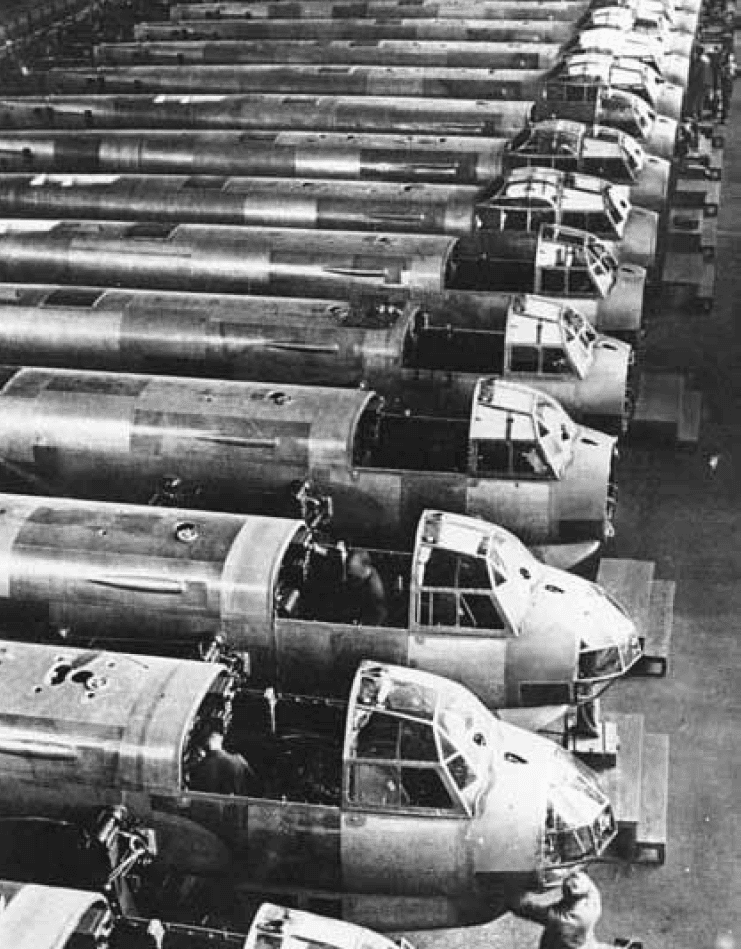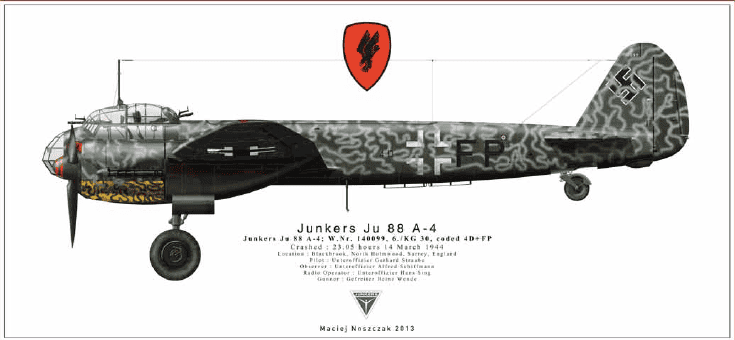
Image: Bundesarchiv Bild 101l -363-2288-11/Rompel/CC-BY-SA
The Junkers Ju 88 was designed in the mid-1930s as a fast bomber (‘schnellbomber’). Scheduled for service in 1938, developmental problems meant that the aircraft did not become available until the day of the attack on Poland in September 1939. It became one of the Luftwaffe’s most versatile combat aircraft. More than 16,000 were built in different versions: dive bombers, fighter bombers, attack bombers, heavy fighters and night fighters.

The aircraft which crashed at Blackbrook was a Junkers Ju 88 version A-4 which had a longer wingspan and more powerful engines than earlier models. The A-4 was brought into service in the closing days of the Battle of Britain in the autumn of 1940. It was a highly effective military aircraft. 16,000 of the aircraft were produced. So versatile were they that they were nick-named ‘The Maid of All Work’.
Over fourteen metres long and with a wingspan of twenty metres, the Junkers Ju 88 A-4 had a maximum take-off weight (when loaded with fuel and bombs) of 14,000 kilograms and a top speed of over 500 kilometres per hour. When fully fuelled it had a range of nearly two and a half thousand kilometres. As with the plane that came down at Blackbrook, the Junkers Ju 88 A-4 usually flew with a crew of four, including the pilot and a bombardier who operated the machine gun that was mounted on the front windscreen and which fired forwards. The two machine guns mounted in the back of the cockpit which fired to the rear, and the twin machine gun in the ventral rear position, were operated by the radio operator and the navigator.

The Junkers Ju 88 A-4 was able to carry up to 900 kilograms in bombs in the main internal bomb bay and up to 500 kilograms in bombs in a secondary bay created by removing fuel tanks. The plane that crashed at Blackbrook had been carrying four 250 kilogram high explosive bombs, three 50 kilogram high explosive bombs and one 50 kilogram phosphorous incendiary bomb, all of which had been jettisoned prior to the crash.
Biography of a Bomber
This speculative ‘biography’ of Junkers Ju88 A-4 WNr. 140099 has been compiled from records of where its unit served from its manufacture in January 1942 to its last operation in March 1944. It reveals the huge area over which the aircraft was deployed and the number of fronts on which the Germans were fighting. Maps found on the aircraft covered the Adriatic, the United Kingdom and central Europe but its area of operation appears to have been wider even than that.
| January 1942 | Junkers Ju88 A-4 WNr. 140099 was manufactured by Junkers Flugzeug-und Motorenworke AG in Bernburg, Germany. It was assigned to 6 Staffel Gruppe II Kampfeschwader 30 (KG 30). |
| 9th July 1942 | The aircraft flew from Tallinn in occupied Estonia to Malmi in Finland. On 10th July it flew on to Pori (Finland), then joined the rest of KG30 at Banak in occupied Norway. |
| April to August 1942 | From its base in Norway unit KG30 targeted the Soviet port of Murmansk, the Allied Arctic convoys bring in supplies by sea, and the railway running southwards into the heart of the Soviet Union. |
| 19th August 1942 | KG30 was transferred to the airfield at Kemi in Finland to carry out a fire-raid on the Soviet port of Archangel on 25th/26th August 1942. |
| 13th September 1942 | The crews of KG30 flew high altitude bombing missions to disrupt an Allied convoy, while Ju88 torpedo bombers of KG26 went in at low level. By the end of the battle, which lasted several days, 13 Allied merchant ships had been destroyed. |
| 9th November 1942 | As Anglo-American forces landed in Morocco and Algeria the Luftwaffe re-deployed much of its bomber force from Norway and Finland to the western Mediterranean. The aircraft flew to Comiso in Sicily via München. From Comiso the unit conducted a sustained bombing offensive against the Allies’ supply ports in north-west Africa, in an effort to disrupt the Allied advance into Tunisia. They also carried out anti-shipping operations and escorted German supply convoys across the Sicilian Narrows to German troops in Tunisia. |
| May 1943 | With the surrender of the Axis troops in north Africa the unit was withdrawn from Sicily and sent to Denmark and then back to the Germany for reorganisation and re-equipment. Young and inexperienced crews now made up the bulk of unit KG30’s strength. After a period of training they were considered ready to join the fray in August 1943. |
| 25th August 1943 | In anticipation of the Allied invasion of Italy from north Africa the Luftwaffe stationed its main strike force of Ju88s in Foggia. Unit KG30 was ordered to disrupt the Allied invasion build-up by long range bombing attacks on north Africa. Following the Allied landing at Salerno the Ju88s stationed at Foggia attacked shipping in the Gulf of Salerno, often twice a night. But the Luftwaffe had realised that faster and smaller single-engined fighter bombers were more effective against heavily defended shipping so the one-time “Wunderbomber” Ju88s were often relegated to operating at night. |
| 25th September 1943 | As the Americans broke out of the beachhead at Salerno and drove north, KG30 was relocated to Villafranca in northern Italy to counter the British advance up the eastern side of the country. Bad winter weather, poor aircraft serviceability and the inexperience of many of the crews, led to a sharp decline in the number of operations the Luftwaffe was able to conduct during the following months. Raids on the port of Naples proved costly, with many novice crews falling victim to Allied night-fighters and sustained fire from the ground. In an effort to conserve its dwindling resources in the face of mounting opposition, by the end of 1943 virtually all of the Luftwaffe’s Ju88s had been withdrawn from Italy and had returned to Germany. |
| 14th December 1943 | Unit KG30 arrived in Varel in Northern Germany for a refit and crew training period. It is likely that the young crew that died at Blackbrook came together during this period. |
| 23rd January 1944 | KG30 was hastily re-deployed back to northern Italy when the Allies landed at Anzio. A map fragment found at the crash site marks the aircraft’s temporary base near Nimes in southern France. This base was used when the aircraft was returning to Italy from Germany so it is likely that the crew that died at Blackbrook flew with the aircraft to Italy as navigators tended to keep their own set of maps. From Bergamo airfield the Ju88s attacked Allied supply shipping in an attempt to disrupt the build-up at the beachhead. But, as at Salerno, the Ju88 was not suited to this role and the planes were again restricted to small-scale night time raids. |
| 6th March 1944 | Unit KG30 arrived back at its base in Varel. |
| 14th March 1944 | Junkers Ju88 A-4 WNr. 140099 took off from Varel heading for London. It did not return. |
Last : Enemy Plane Down
Next : Personal Memories

